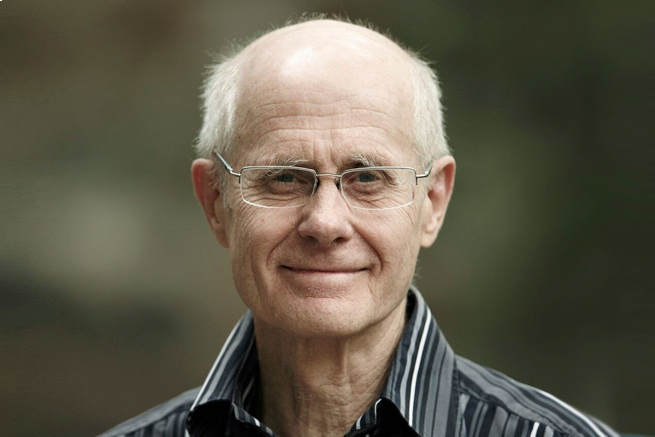
OTTAWA, February 28, 2017 — One of Canada’s most important and influential urban designers, whose portfolio includes Toronto’s CN Tower, Ottawa’s Parliamentary Precinct, the Wascana Centre in Regina and projects at more than 25 university campuses, is the recipient of the 2017 RAIC Gold Medal.
Roger du Toit, FRAIC, established his practice in Toronto in 1975, now known as DTAH, He was not only a professional architect but also a certified landscape architect and planner. Born in South Africa, he died in 2015, aged 75, from injuries suffered in a bicycle accident.
The RAIC Gold Medal is the highest honour the profession of architecture in Canada can bestow. It recognizes a significant and lasting contribution to Canadian architecture. du Toit’s wife Sheila du Toit and their sons Rob du Toit and Andre du Toit will accept the award at the RAIC/OAA Festival of Architecture taking place in Ottawa May 24-27.
“He was a leader and an innovator,” wrote the five-member selection jury. “He has made timeless contributions to significant parts of our urban environments across the country. He developed a unique career that transcended traditional understanding of architectural practice. His work encompassed planning, urban design, community development and architecture.”
In a career spanning more than 45 years, du Toit was involved in significant projects such the Distillery District and Queens Quay in Toronto; Confederation Boulevard and the Long Term Vision and Plan for the parliamentary and judicial precincts in Ottawa and the Downtown South Urban Design in Vancouver. He also handled over 45 projects at more than 25 university campuses, including Carleton University, Queen’s University and the University of Regina.
“He was very much the ‘master architect’ working and coordinating a wide range of groups, institutions, and communities,” said the jury. “He anticipated and planned for unknown futures. He took stewardship on as an important component of his relationship with his clients. He was also committed to research, teaching, and sharing.
“His work inspired many professionals and firms that followed his pioneering in urban design,” said the jury. “He made us aware that our community projects could go way beyond the traditional notions of just streetscapes.”
The jury members were: Barry Johns, FRAIC, Patricia Patkau, FRAIC, Tom Emodi, FRAIC, David Scott, MRAIC, Wayne DeAngelis, PP/FRAIC and Ricardo Castro, FRAIC.
Previous Gold Medalists include Peter Busby, FRAIC, His Highness the Aga Khan, Peter Cardew, FRAIC, Bing Thom, FRAIC, George Baird, FRAIC, John and Patricia Patkau, FRAIC, Dan Hanganu, FIRAC, Mario Saia, FIRAC, Bruce Kuwabara, FRAIC, Richard Henriquez, FRAIC, Jane Jacobs, Ralph Erskine, Arthur Erickson, FRAIC, Eberhard Zeidler, FRAIC, Phyllis Lambert, FRAIC, Barton Myers, Moshe Safdie, FRAIC, Raymond Moriyama, FRAIC, and Jack Diamond, FRAIC.
Biographical notes
Roger Terence du Toit was born in Cape Town, South Africa on Dec. 20, 1939. He earned a bachelor of architecture from the University of Cape Town in 1963, moved to Toronto in 1965 and received his master’s degree in architecture from the University of Toronto in 1966. That year, he joined John Andrews Architects. During his time there, he was a key figure in Metro Centre, the railway lands redevelopment plan that resulted in the CN Tower, and served as project manager for its construction. He also co-authored On Building Downtown, the first design guidelines for downtown Toronto, published in 1974.
In 1975, he established Roger du Toit Architects with his wife Sheila, who acted as the firm’s business manager. In 1985, the firm evolved into du Toit, Allsopp, Hillier, and in 2012 became known by its acronym DTAH.
For more than 30 years, starting in 1982, du Toit oversaw the long-range plan of the Wascana Centre in Regina, a 2,300-acre park built around Wascana Lake that encompasses the provincial Legislative Building, among other community buildings.
du Toit also left a legacy in the National Capital Region, beginning with a 1982 siting study for the National Gallery of Canada and the Canadian Museum of Civilization (now the Canadian Museum of History). In 1983, his firm devised the ceremonial route, now Confederation Boulevard, that connects the nation’s major political and cultural institutions in Ottawa and Gatineau.
He was the driving force behind the Long Term Vision and Plan for Ottawa’s parliamentary and judicial precincts, completed in 1987 with an update in 2006, which guides the development and preservation of Canada’s most important cultural and political symbols.
In the 1990s, he initiated a process for developing building height regulations in Ottawa to protect the views of national symbols such as the Parliament Buildings; created a framework for the University of British Columbia’s expansion that preserved the site’s old-growth forest; and spearheaded the heritage master plan for the 19th-century Gooderham and Worts Distillery District, now a major cultural destination.
From 2000 to 2015, du Toit helped develop the planning basis for the revitalization of Toronto’s Central Waterfront and his firm designed (with West 8) some of its key components: Queen’s Quay and the WaveDeck structures.
He also completed projects in Australia, Hong Kong, the Middle East and the United States.
ABOUT THE RAIC
The Royal Architectural Institute of Canada is the leading voice for excellence in the built environment in Canada. Representing about 5,000 members the RAIC advocates for excellence, works to demonstrate how design enhances the quality of life and promotes responsible architecture in addressing important issues of society.



